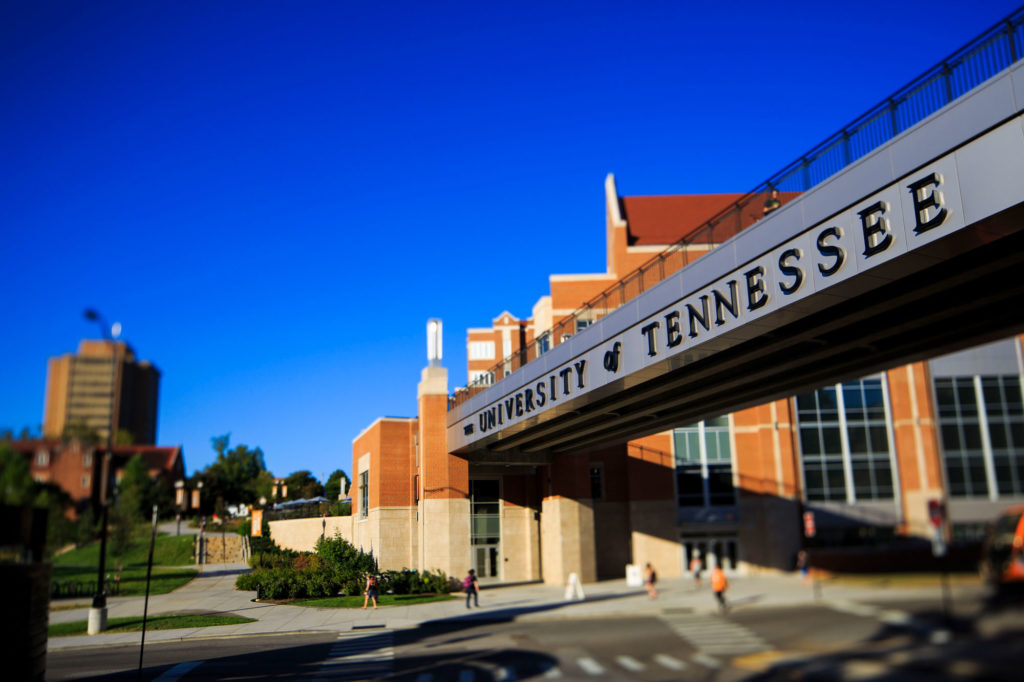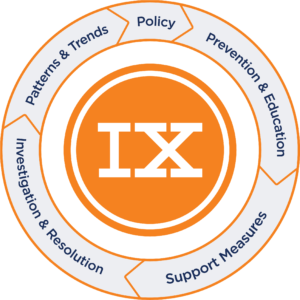Standard of Conduct 7: Title IX Process
Student Conduct and Community Standards (SCCS) works closely with the Office of Title IX (OTIX) to investigate allegations of Prohibited Conduct related to the University’s Policy on Sexual Harassment, Sexual Assault, Dating and Domestic Violence, and Stalking.
Upon receiving a report of alleged Prohibited Conduct, the OTIX will reach out to potential Complainants in order to provide support and resources. If Complainant’s decide to file a Formal Complaint alleging Prohibited Conduct against a Respondent, OTIX will forward a signed Formal Complaint to SCCS. This initiates SCCS’s investigative process, at which point SCCS will take the following steps:
Notice of Receipt of Formal Complaint
Upon receiving a Signed Formal Complaint from the Office of Title IX, SCCS will distribute a “Notice of Receipt of Formal Complainant” to the Complainant and the Respondent. This letter will contain a brief summary of the alleged Prohibited Conduct including the approximate time, date, and location of the alleged Prohibited Conduct, as well as relevant policy definitions.
from the Office of Title IX, SCCS will distribute a “Notice of Receipt of Formal Complainant” to the Complainant and the Respondent. This letter will contain a brief summary of the alleged Prohibited Conduct including the approximate time, date, and location of the alleged Prohibited Conduct, as well as relevant policy definitions.
This notice will also include information such as Complainant and Respondent rights, process guidelines, resolution and hearing options, and an advisor information sheet.
Notice of Meeting/Interview
Shortly after receiving the Notice of Receipt of Formal Complaint, the Complainant and Respondent will each receive a separate Notice of Meeting/Interview.
of Receipt of Formal Complaint, the Complainant and Respondent will each receive a separate Notice of Meeting/Interview.
During the meeting/interview parties will have the opportunity to ask questions about the grievance process and provide information about the allegations. Each party may also be accompanied by an advisor and/or support person during the meeting/interview.
Investigation
Next, SCCS investigators will begin the investigative process. This includes party meetings/interviews, witness interviews, and evidence gathering. Investigators will gather documentation from parties and witnesses. This includes text messages, voice messages, social media screenshots, photographs, cell phone data, and other relevant information.
the investigative process. This includes party meetings/interviews, witness interviews, and evidence gathering. Investigators will gather documentation from parties and witnesses. This includes text messages, voice messages, social media screenshots, photographs, cell phone data, and other relevant information.
Party Evidence Review
After the investigative phase, SCCS will provide all parties and their advisors (if any) with an opportunity to review any evidence obtained by the University that is directly related to the allegations, regardless of whether the University intends to use the evidence in a hearing. Both parties and their advisors (if any) are then given ten (10) business days to review the evidence.
will provide all parties and their advisors (if any) with an opportunity to review any evidence obtained by the University that is directly related to the allegations, regardless of whether the University intends to use the evidence in a hearing. Both parties and their advisors (if any) are then given ten (10) business days to review the evidence.
During this time, parties may submit a written response to the evidence to SCCS. This response is limited to the evidence presented and may include new information or information a party believes is missing from the document.
SCCS will then consider any timely-submitted written response before completing the investigative report.
Investigative Report and Non-Binding Recommendations
Next, SCCS compiles the Investigative Report and provides the Report to both parties and their advisor (if any) for review. Included in the Investigative Report are the Investigator’s Non-Binding Recommendations. Both parties and their advisors (if any) are then permitted ten (10) business days to submit a response to the Investigative Report, if desired.
Report and provides the Report to both parties and their advisor (if any) for review. Included in the Investigative Report are the Investigator’s Non-Binding Recommendations. Both parties and their advisors (if any) are then permitted ten (10) business days to submit a response to the Investigative Report, if desired.
The written response is limited to the information provided in the Investigative Report.
Resolution Options
After the distribution of the Investigative Report and Non-Binding Recommendations, parties will have several resolution options available, dependent on the jurisdiction of the allegations. Resolution options include:
Non-Title IX Prohibited Conduct Options:
- Resolution Agreement: A Resolution Agreement is a document the Respondent signs to 1. Accept responsibility for the violation of the Standard(s) of Conduct, 2. Accept the recommended sanction(s), 3. Waive rights to a formal hearing.
- Alternative Resolution: An Alternative Resolution is a mutual agreement as an alternative to the traditional Student Conduct Process.
- Student Conduct Board Hearing: A Student Conduct Board Hearing is conducted by a pool of trained University students, faculty, and staff. The Student Conduct Board determines whether the Respondent violated the Standard(s) of Conduct and what sanctions to impose.
- Student Life Hearing Officer: A Hearing before a Student Life Hearing Officer is conducted by a trained University employee. The Student Life Hearing Officer determines whether the Respondent violated the Standard(s) of Conduct and what sanction(s) to impose.
- Uniform Administrative Procedures Act Hearing (UAPA): A UAPA Hearing is conducted in accordance with the University’s procedures for conducting contested cases under UAPA Chapter 1720-01-05.
Title IX Prohibited Conduct Options:
- Informal Resolution: An Informal Resolution is a mutual agreement to resolve a Formal Complainant of Title IX Prohibited Conduct without a complete investigation and/or Title IX Hearing.
- Title IX Hearing: A Title IX Hearing is the only available hearing option after a Title IX Prohibited Conduct investigation. The hearing is conducted by a trained Title IX Hearing Officer. The Title IX Hearing Officer determines whether the Respondent violated the Standard(s) of Conduct and what sanction(s) to impose.
*Note: All resolution options are not available in all cases – see Code.
*Both Parties have various appeal options following hearing outcomes and no action determinations – see Code.

